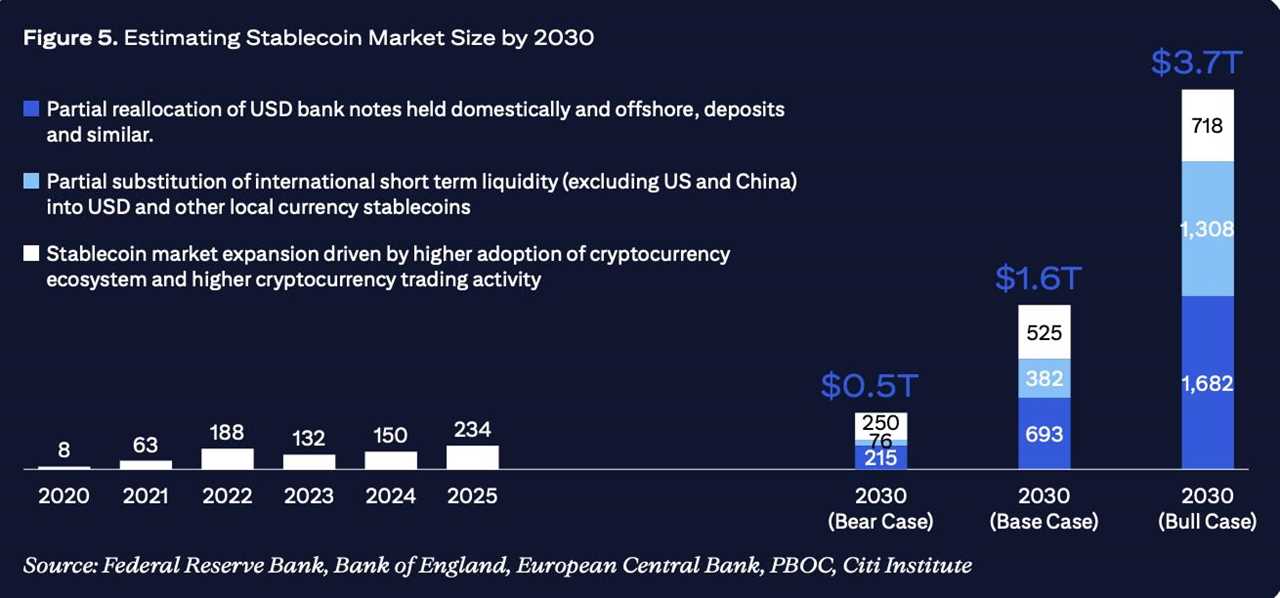According to the latest report from Citi Bank, stablecoins are steadily becoming the core infrastructure for payments and value storage in the decentralized finance era, with the market projected to reach $1.6 trillion (base case) to $3.7 trillion (bull case) by 2030. Wall Street is identifying the next major growth catalyst for digital assets – and it’s stablecoins.
Stablecoins – The Bridge Between Traditional Finance and the On-chain World
Citi’s Identified Growth Drivers
Stablecoin market capitalization has surged from $8 billion in 2020 to $188 billion in 2022, and is expected to reach around $234 billion by 2025, and the enactment of the GENIUS Act in July.
This number is increasing year by year and there is continuous good news from the government as well as the market, along with careful research, leading Citi believes stablecoins are entering a new phase of evolution.Transforming from a trading instrument within crypto into a global payment layer that bridges traditional finance and blockchain systems.
Learn more: What Happened To The Crypto Today?

Stablecoins – The Bridge Between Traditional Finance and the On-chain World – Source: Federal Reserve Bank
The report highlights several key growth drivers:
- Partial substitution of USD cash holdings, as individuals and companies in volatile economies increasingly use stablecoins as an accessible “safe haven.”
- Reallocation of short term liquidity from bank deposits and money market funds (MMFs) to stablecoins, thanks to their 24/7 cross border payment capabilities.
- Expansion in non USD markets, particularly in Europe and the U.K., even as USD backed stablecoins are expected to maintain around 90% market dominance.
- Growth alongside public cryptocurrency markets, as stablecoins continue to serve as payment intermediaries, on/off ramps, and collateral in DeFi.
Stablecoins and CBDCs: A Multipolar Financial System
Citi compares the development of stablecoins to the evolution of the card industry. Initially dominated by global networks (Visa, Mastercard), later followed by national payment systems (such as RuPay in India and Pix in Brazil) established to protect monetary.
All of this could create a multipolar financial landscape where private stablecoins and public CBDCs coexist and compete, especially in wholesale and corporate payments.
What Could Make or Break the Stablecoin Market
Erin McCune, founder of Forte FinTech, believes that stablecoins could grow 5-10 times their current size if three key conditions are met:
- Regulatory clarity and support in major markets such as the U.S., Europe, Latin America, and Africa.
- Public and corporate confidence in the 1:1 convertibility between stablecoins and fiat currencies.
- Collaboration between traditional banks and stablecoin issuers to integrate new payment technologies into existing financial infrastructure.
However, McCune also warns that if a major depegging event or reserve failure occurs, the market could stagnate around $300-500 billion, confined to crypto trading and a few remittance corridors.
Stablecoins Set to Reshape Global Payments
Citi forecasts that over the next decade, stablecoins will move far beyond their current use in crypto trading and DeFi, gradually integrating into mainstream financial operations.
At present, crypto and DeFi trading account for around 90-95% of total stablecoin activity. Even as the market matures, trading both retail and DeFi, will likely remain a major use case.
One promising area is corporate and B2B payments, as businesses adopt stablecoins to pay cross-border suppliers and manage treasury, especially in emerging markets where the traditional banking system remains slow and expensive.
Consumer remittances also present strong potential, as stablecoins can lower transfer fees and settlement times compared to existing remittance systems. A meaningful advantage in the nearly $1 trillion global remittance market.
Additional applications are also a big opportunity. In institutional trading and capital markets, where stablecoins can streamline securities settlement and money transfers, and in interbank liquidity management, as banks explore blockchain-based solutions to optimize real-time cash flows.
Citi concludes that this ongoing diversification signals a fundamental shift. Stablecoins are evolving from niche trading instruments to a core layer of digital financial infrastructure, linking blockchain-based systems with traditional forms of global payments.
The post Citi Bank: Stablecoins Could Reach $3.7 Trillion by 2030 appeared first on NFT Plazas.
Read MoreBy: NFTPlazas
Title: Citi Bank: Stablecoins Could Reach $3.7 Trillion by 2030
Sourced From: nftplazas.com/citi-bank-stablecoin-market-2030/
Published Date: Tue, 21 Oct 2025 12:15:38 +0000
----------------------------
.png)





